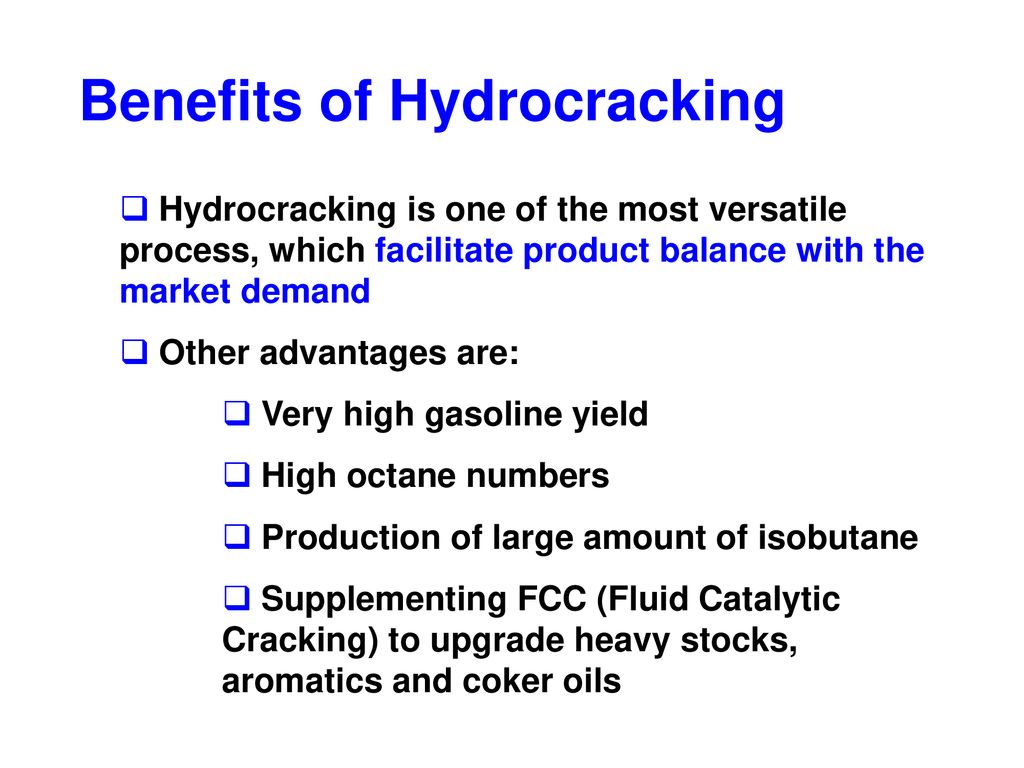
Advantages Of Hydrocracking Reaction
The reaction of desulphurisation, denitrogenation and de-oxygenation. The latter reactions are essentially treating processes, which are used as a separate processing step when other types of cracking units are used. Thus there are two steps of reactions in Hydrocracking – The cracking step and the treating step. Component in the hydrocracking catalyst affects catalyst selectivity, not only by forming. Component and of an excess of hydrogen in the hydro- cracking reaction. A key advantage of hydrocracking over cracking is the flexibility of the.
Hydrocracking Why hydrocracking is preferred? (1) The demand for petroleum products has shifted to high ratios of gasoline and jet fuel compared with the usages of diesel fuel and home heating oils. (2) By-product hydrogen at low cost and in large amounts has become available from catalytic reforming operations. (3) Environmental concerns limiting sulfur and aromatic compound concentrations in motor fuels have increased. Advantages of hydrocracking 1. Better balance of gasoline and distillate production. Greater gasoline yield.
Improved gasoline pool octane quality and sensitivity. Production of relatively high amounts of isobutane in the butane fraction. Pixel shader 20 directx 90 free download pc. Supplementing of fluid catalytic cracking to upgrade heavy cracking stocks, aromatics, cycle oils, and coker oils to gasoline, jet fuels, and light fuel oils. Hydrocracker feed stock Hydrocracker uses more aromatic cycle oils and coker distillates as feed. These feed streams are very refractory and resist catalytic cracking, while the higher pressures and hydrogen atmosphere make them relatively easy to hydrocrack. The cycle oil is a difficult fraction to crack catalytically to extinction, therefore make satisfactory feedstocks for hydrocracking. Vacuum and coker gas oils are also used as hydrocracker feed.
Diesel boiling range materials may be included in hydrocracker feed to make jet and motor gasoline products. Residual fuel oils and reduced crude can also be processed in hydrocrackers. Hydrocracking operation is broken into two general types. Those which operate on distilled feed (hydrocracking) and those 2. Which process residual materials (hydroprocessing). Theses two processess differ by 1.
Type of catalyst used. Operating conditions. Hydrocracking Reactions Many simultaneous chemical reactions occur in hydrocracking. Mechanism of hydrocracking is that of catalytic cracking with hydrogenation superimposed. Catalytic cracking is the scission of a carbon–carbon single bond, and hydrogenation is the addition of hydrogen to a carbon–carbon double bond. Cracking and hydrogenation are complementary. For cracking provides olefins for hydrogenation, while hydrogenation in turn provides heat for cracking.
The cracking reaction is endothermic and the hydrogenation reaction is exothermic. The overall reaction provides an excess of heat because the amount of heat released by the exothermic hydrogenation reactions is much greater. Excess heat causes the reactor temperature to increase and accelerate the reaction rate. Excess heat is controlled by injecting cold hydrogen as quench into the reactors to absorb the excess heat of reaction. Initial hydrogenation of a condensed aromatic compound to a cycloparaffin. Converts a low-value component of catalytic cycle oils to a useful product.
Isomerization is another reaction type that occurs in hydrocracking and accompanies the cracking reaction. The olefinic products formed are rapidly hydrogenated, thus maintaining a high concentration of high octane isoparaffins. The volumetric yield of liquid products can be as high as 125% of the feed because the hydrogenated products have a higher API gravity than the feed. Reaction Conditions Normally carried out at average catalyst temperatures between 290 to 400°C and at reactor pressures between 1200 and 2000 psig (8275 and 13,800 kPa). The circulation of large quantities of hydrogen with the feedstock prevents excessive catalyst fouling and permits long runs without catalyst regeneration. Hydrocracking Catalyst Most of the the hydrocracking catalysts consist of a crystalline mixture of silica-alumina with a small uniformly distributed amount of rare earths contained within the crystalline lattice. The silica-alumina portion of the catalyst provides cracking activity while the rare-earth metals promote hydrogenation.